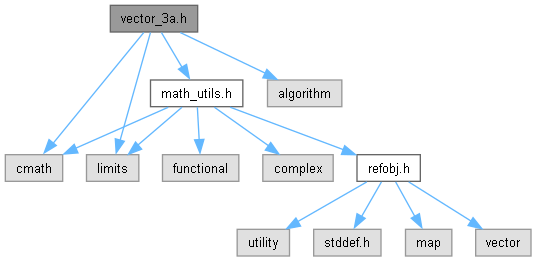Loading...
Searching...
No Matches
N-dimensional vectors and some useful functions for work with them. More...
Include dependency graph for vector_3a.h:

This graph shows which files directly or indirectly include this file:

Classes | |
| struct | vec_prod_traits< T, N > |
| Traits class for vector product. More... | |
| class | Vector_Nt< T, N, storage_t > |
| N-dimensional vector of the type T and some useful operations. More... | |
| struct | vec_less< vec_t > |
| Comparison in the order of components. More... | |
Macros | |
| #define | VEC_INFTY std::numeric_limits<vec_type>::max() |
| "infinitely large" number | |
| #define | INT_INFTY std::numeric_limits<int>::max() |
| "infinitely large" integer number | |
| #define | MULT_EPSILON 1024 |
| how bigger is "ininitely small" number then std::numeric_limits<...>::epsilon(). | |
| #define | VEC_ZERO (MULT_EPSILON*std::numeric_limits<vec_type>::min()) |
| "infinitely small" number for multiplication and division (here smallest to be able to divide by) | |
| #define | VEC_ZERO_EPS (MULT_EPSILON*std::numeric_limits<vec_type>::epsilon()) |
| "infinitely small" number (compared to 1) for addition and subtraction. | |
Functions | |
| template<class T > | |
| Vector_Nt< T, 3 > | operator% (const Vector_Nt< T, 3 > &x, const Vector_Nt< T, 3 > &y) |
| Vector product for N=3. | |
| template<class T > | |
| vec_type | operator% (const Vector_Nt< T, 2 > &x, const Vector_Nt< T, 2 > &y) |
| Vector product for N=2. | |
| vec_type | vec_area (const Vector_2 &vect1, const Vector_2 &vect2) |
| returns polygon area based on vectors vect1 and vect2 | |
| vec_type | dist_max (Vector_3 *va1, Vector_3 *va2, int n) |
| finds the maximum distance between vector pairs | |
| vec_type | dist_av (Vector_3 *va1, Vector_3 *va2, int n) |
| finds average distance between vector pairs | |
| vec_type | diff_av (Vector_3 *va1, Vector_3 *va2, int n, int *minind=0, int *maxind=0) |
| finds the average difference norm between two vector sets of the same length optionally gives the indices for maximal and minimal difference va2 can be nullptr, then the norm of va1 is used | |
| Vector_3 | FindPerp (const Vector_3 &vAB) |
| finds suitable perpendicular to a vector | |
| Vector_3 | GetScope (const Vector_3 *varr, long n, Vector_3 *box_min, Vector_3 *box_max) |
| Returns the average (center) vector of the vector array and coordinates of a minimal box in which it is contained. | |
| Vector_3 | GetIScope (const Vector_3 *varr, long *indarr, long n, Vector_3 *box_min, Vector_3 *box_max) |
| the same with long index array | |
| Vector_3 | GetIScopei (const Vector_3 *varr, int *indarr, int n, Vector_3 *box_min, Vector_3 *box_max) |
| the same with int index array | |
| void | clear_vecarri (int n, Vector_3 *vec, int *ind=0) |
| clears vector array with optional integer index | |
| Vector_3 | Reflect (Vector_3 &ini, double t, Vector_3 &dir, double *box, int flag=0x7, const Vector_3 &force=Vector_3()) |
| reflects the vector ini+dir*t+0.5*force*t^2 to be inside a box limited by 0 and box sizes changes dir according to the final state fills crossed dir with bit flags corresponding directions along which the walls were crossed | |
| template<class vec_inp_it > | |
| Vector_3 | get_extent (vec_inp_it beg, vec_inp_it end, Vector_3 *box_min=nullptr, Vector_3 *box_max=nullptr) |
| Calculates extent of the vector container. | |
| template<class inp_it , class vector_tt > | |
| vector_tt::value_type | gramm_schmidt_project (inp_it orth_set_beg, inp_it orth_set_end, const vector_tt &inp_vec, vector_tt &out_vec) |
| Performs a step of the Stabilized Gramm-Schidt orthonormalization algorithm. | |
| template<class T , int N> | |
| T | distance2edge (const Vector_Nt< T, N > &point, const Vector_Nt< T, N > &e1, const Vector_Nt< T, N > &e2, Vector_Nt< T, N > *pos=nullptr) |
| Calculates a distance between a poinbt point and an edge formed by points e1 and e2. | |
Detailed Description
N-dimensional vectors and some useful functions for work with them.
Macro Definition Documentation
◆ MULT_EPSILON
| #define MULT_EPSILON 1024 |
how bigger is "ininitely small" number then std::numeric_limits<...>::epsilon().
We use this parameter since std::numeric_limits<...>::epsilon() is too small.
◆ VEC_ZERO_EPS
| #define VEC_ZERO_EPS (MULT_EPSILON*std::numeric_limits<vec_type>::epsilon()) |
Function Documentation
◆ get_extent()
template<class vec_inp_it >
| Vector_3 get_extent | ( | vec_inp_it | beg, |
| vec_inp_it | end, | ||
| Vector_3 * | box_min = nullptr, |
||
| Vector_3 * | box_max = nullptr |
||
| ) |
Calculates extent of the vector container.
- Returns
- the center of the vector set, optionally (if arguments are not nullptr) fills the bounding box in box_min, box_max.
◆ gramm_schmidt_project()
template<class inp_it , class vector_tt >
| vector_tt::value_type gramm_schmidt_project | ( | inp_it | orth_set_beg, |
| inp_it | orth_set_end, | ||
| const vector_tt & | inp_vec, | ||
| vector_tt & | out_vec | ||
| ) |
Performs a step of the Stabilized Gramm-Schidt orthonormalization algorithm.
Given a set of orthogonal unit vectors defined by [orth_beg, orth_end) orthonormalizes inp_vec with respect to this set (removes all projections to the set). The result is recorded to out_vec, which is normalized.
- Returns
- the norm of out_vec before normalization. If return value is <=VEC_ZERO, then inp_vec may be considered as linearly dependent of the supplied set.